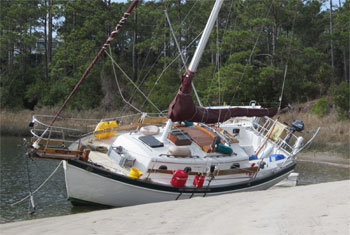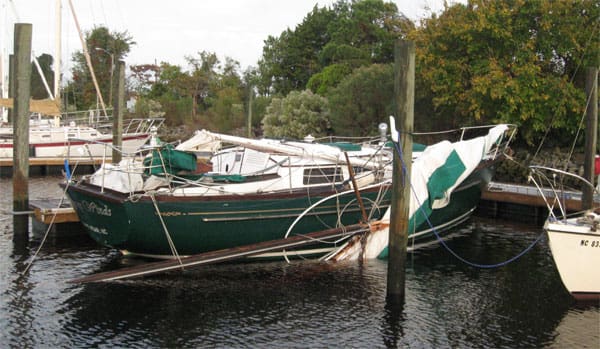One of the more confusing issues a sailor must face is that of marine insurance. Unlike car or homeowners insurance, marine insurance is not regulated by laws that govern rates and coverage. To make matters worse, many agents selling marine insurance do not really understand the intricacies and nuances of marine insurance. In order to get the best coverage at the best price, a boat owner really needs to understand their policy, what it covers and, more important, what it does not cover.
What you think your boat and its equipment are worth and what the insurance company thinks they’re worth may be two different things. Understanding this is important to understanding your coverage. Let’s look at some of the terminology.
Book Value: A value based on what standard sources such as BUC and NADA say a boat of equal age and condition is worth. This works well on newer boats, but can be way off for older boats and boats with major upgrades after purchase.
Stated or Agreed Value: You and your insurance company agree to what your boat is worth. Usually if the boat is more than eight to 10 years old, the insurance company requires a survey to establish this value. For boats less than eight to 10 years old, the value is often based on the purchase price less depreciation. If you have a newer boat with major upgrades such as an electronics package or new suit of sails, it is wise to make sure you keep records to prove you have had the upgrades.
 |
Actual Cash or Replacement Value: Usually applied to equipment on board, this is based on what something is worth if it was to be sold today. Normally this will be used to value things like electronics, sails and engines. That 10-year-old chartplotter may only be worth $250 on the open market even though you paid $3,000 for it! Your replacement cost may be $3,000, but the insurance will only pay $250. Once again keep records of recent upgrades to help prove values.
Waiver of Depreciation or Replacement Cost: Some policies (usually for additional cost) will allow full replacement costs for equipment. This really is the best way to go if you can get it. Ask your agent, it may cost a bit more but could well be worth it in the long run.
Hybrid Policies: Hybrid policies are the most common and will often pay the Agreed Value for a hull or total loss but only pay Actual Cash Value for partial or equipment damage. The insurance company may use a depreciation schedule for items such as engines, electronics, and even your mast and rig. Once again it is important to keep records of any upgrades.
What is covered in your policy and what is not? This can be a bit tricky. Marine insurance is considered “all inclusive” meaning it covers everything. That said almost all policies will be filled with exclusions or what they do not cover. Often these exclusions are on separate sheets and not in the main body of your policy.
Exclusions often include things like: acts of war, vessel seizure, wear and tear, manufacturer defects, terrorism and even nuclear contamination! Some policies will exclude named or numbered wind storms as well. Additionally, you are likely to be restricted to limited cruising grounds. Understand your policy, you do not want to find out after a loss that you were not covered. If in doubt ask your agent. In the end it is up to the owner to know their policy.
Be sure you understand your deductible as well. The deductible can vary depending on the type of loss. Some policies will have higher deductibles for named storm damage, lightning damage, and rig or sail damage.
Protection and Indemnity or Liability: If you have no other insurance on your boat you should at least have liability or P & I insurance. In fact, most marinas require proof of liability insurance before they will give you a slip or do work on your boat. Liability covers you for damage or injury caused by you or your boat. Marinas require this so that if someone trips over your dock line they will be protected by your insurance, not theirs. This also protects you should a guest aboard be injured even though that injury is no fault of yours. Your liability should cover wreck removal and oil spill cleanup as well. This will cover expenses should your boat sink and be legally required to be removed, often the case in channels, marinas and public beaches. If you own a home, your homeowner’s policy is likely to cover some of your personal liability. This is part of your umbrella policy. But if you rent a home or apartment or live aboard you need to make sure you are covered even while away from your boat. Check with your homeowner’s agent to see just what is covered in regards to your boat before deciding how much you need for your boat owner’s policy.
Finally let’s look at insurance for the live aboard sailor and the long-range cruiser. If you are a live-aboard sailor you may already know getting insurance for you and you boat is not easy. Most companies will not cover live-aboard boaters. Different companies will state different reasons for this, but it boils down to a higher liability risk for the insurance companies. Additionally the value of your personal belongings will be higher and the live-aboard creates more wear and tear on a boat resulting in a greater chance of loss from equipment failure. Although it may be harder to get, it is not impossible and in recent years some insurance companies are finding this a profitable niche market. Also keep in mind if you live aboard for more than a few weeks a year you need to let your insurance company know. Insurance firms consider this “material misrepresentation” and could result in your claim being denied.
Insurance for the long-range cruiser is likewise not as easy to get, but as with live-aboard insurance there are companies that will work with you. According to Al Golden of International Marine Insurance Services, “If you plan any long-distance voyaging, it is best to talk to your agent at least a year in advance as some companies have special requirements or others may not cover you at all.”
In the last 10 years or so more companies are writing policies tailored to the cruising sailor as well as the live-aboard. Many traditional companies will write riders that will cover specific cruising areas such as the Bahamas. If you plan on more extended cruising, there are some special policies available to cover you as far as you want to go. Keep in mind these riders and special policies will have restrictions as well. Most require a minimum crew of three to four experienced sailors for example, and many will exclude certain cruising areas or countries such as Cuba and a good part of the Middle East. Also the long-range cruiser must be aware of certain requirements of the host country they are visiting. Mexico, for example, requires that all visiting yachts have liability insurance, the catch being this insurance must be written by a Mexican company. Failure to have the right insurance can result in seizure of the vessel.
Every boat owner needs to take the time to read and understand their insurance policy. A good agent will help guild you. This becomes even more important if you are planning an extended voyage or living aboard.
——————
Capt. Wayne Canning lives on his Irwin 40 Vayu, in Wilmington N.C. He is a full-time marine surveyor, delivery skipper, and consultant/project manager on major repairs. Visit www.4ABetterBoat.com.

